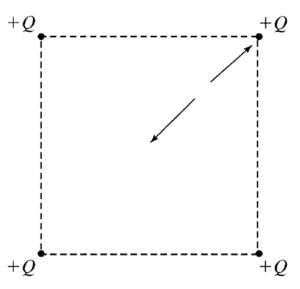Question

Conducting spheres A and B of charges –q and +3q, respectively, are separated by a distance d, as shown in the figure above. Which of the following statements is true about the two spheres?
(A) The magnitude of the force sphere A exerts on sphere B is three times larger than the magnitude of the force sphere B exerts on sphere A.
(B) The magnitude of the force sphere B exerts on sphere A is three times larger than the magnitude of the force sphere A exerts on sphere B.
(C) The force sphere B exerts on sphere A is equal in magnitude to the force sphere A exerts on sphere B.
(D) If the spheres are free to move, the magnitude of the force sphere B exerts on sphere A will decrease as the spheres move.
(E) If the spheres are brought into contact with each other and then returned to the positions shown, the two spheres will attract each other.
Answer/Explanation
Ans:C
The magnitude of force exerted by one charge on another charge can be determined by Coulomb’s law. Coulomb’s law states that the electrostatic force between two charges is directly
proportional to the product of the magnitudes of charges and inversely proportional to the square of the distance between them. \(|F|=\frac{1}{4 \pi\varepsilon _0}|\frac{q_1q_2}{r^2} \)The magnitude of force on sphere A is the same as the magnitude of force on sphere B, since there are only two charged spheres present, and only one value of force can be determined.
Question

A grounded spherical conductor is on an insulating stand. A positively charged rod is brought close to the sphere but does not touch the sphere, as shown above. The rod is moved far away and then the grounding wire is removed. Which of the following describes the resulting charge on the sphere?
(A) Positive
(B) Negative
(C) No net charge, but it is polarized with positive charges on the left side of the sphere
(D) No net charge, but it is polarized with negative charges on the left side of the sphere
(E) No net charge and no polarization
Answer/Explanation
Ans:E. As the positively charged rod is brought near the left side of the grounded spherical conductor, charge separation in the neutral sphere is induced and negative charges move toward the left side of the sphere. However, when the positively charged rod is moved far away from the sphere, the charges will move back to reestablish a neutral sphere and excess negative charges will flow back to the ground. Since the sphere is ungrounded after the rod is removed, the sphere is back to having no net charge and no polarization.
Question
Two stationary point charges of unknown magnitude and sign are isolated from all other charges. If the electric field strength is zero at the midpoint of the line joining them, which of the following can be concluded about the charges?
(A) They are equal in magnitude but opposite in sign.
(B) They are equal in magnitude and have the same sign.
(C) They are not necessarily equal in magnitude but have opposite signs.
(D) They are not necessarily equal in magnitude but have the same sign.
(E) None of the above can be concluded without additional information.
Answer/Explanation
Ans:B
Question

When a positively charged rod is brought near, but does not touch, the initially neutral electroscope shown above, the leaves repel (I). When the electroscope is then touched with a finger, the leaves hang vertically (II). Next when the finger and finally the rod are removed, the leaves repel again (III). During the process shown in Figure II
(A) electrons are going from the electroscope into the finger
(B) electrons are going from the finger into the electroscope
(C) protons are going from the rod into the finger
(D) protons are going from the finger into the rod
(E) electrons are going from the finger into the rod
Answer/Explanation
Ans: B
Questions (a)-(b)

Four particles, each with a charge +Q, are held fixed at the corners of a square, as shown above. The distance from each charge to the center of the square is f.
Question(a)
What is the magnitude of the electric field at the center of the square?
(A) o
(B) \(\frac{4kQ}{\varphi ^{2}}\)
(C) \(\frac{2kQ}{\varphi ^{2}}\)
(D) \(\frac{4kQ}{\sqrt{2}\varphi ^{2}}\)
(E) \(\frac{kQ}{\sqrt{2}\varphi ^{2}}\)
Answer/Explanation
Ans:A
